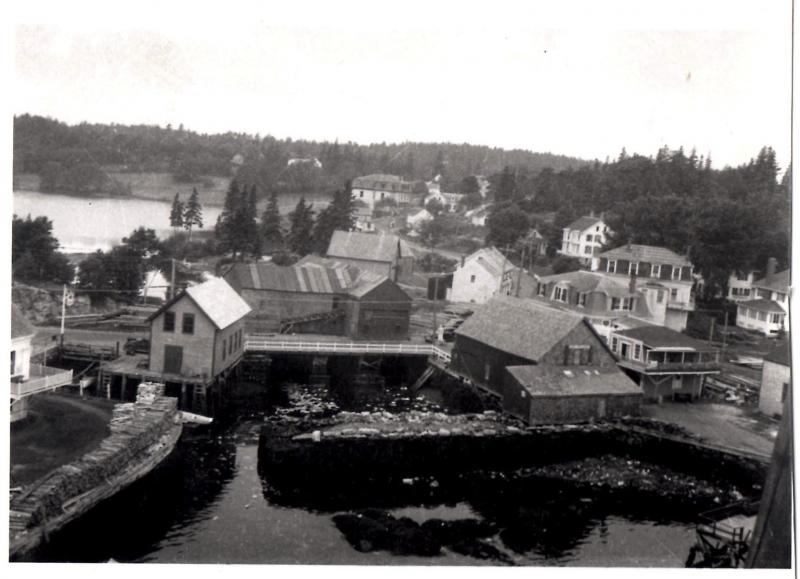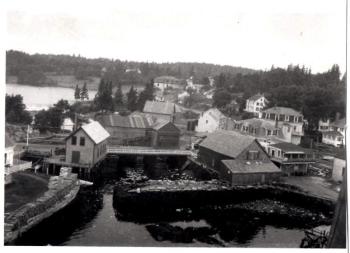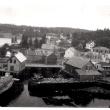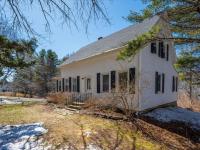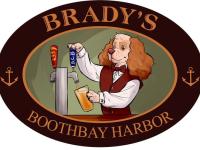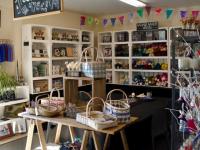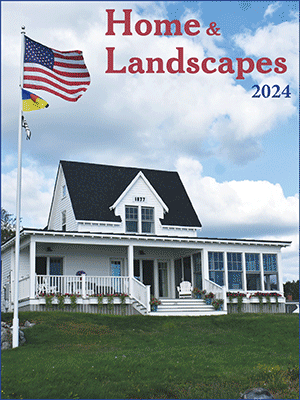East Boothbay view, mid-1930s
More than once I've been kidded about favoring the village of East Boothbay in my local history pursuits. It does stand to reason since I grew up and live there, have fond memories of nearly 65 years, and have written two books using the village loosely as a microcosm for all of Boothbay.
I checked to see if I had in fact written indecently often about village doings in my articles. I was surprised to see that only 10 percent of my 580 articles have been about the village. It's been more than a year since the last one — time for another!
Goudy & Stevens
One of my favorite shots is this west-looking photo from a masthead in Goudy & Stevens shipyard, now Hodgdon Yachts. On the extreme left is the 1840s Benjamin Reed house near Lobsterman's Wharf.
After Goudy & Stevens took over that shipyard site in the mid-1920s, family members lived in the house and also ran the Perkins & Stevens wood and coal company next to the house in the 1930s. Some of the cordwood to be sold is seen stacked along the seawall by the house.
It was a good thing coal still came by shallow coasting schooner. It was a tight squeeze for vehicles coming into the yard and business, having to maneuver between the wood pile and the jutting upper porch. That maneuvering was after negotiating the open water, a gap not yet filled, near the elevated gas pump sign and building just west of the cordwood. That watery spot was useful to lay a vessel alongside for work unhampered by roiled waters. In the 1930s that building by the gas sign was used to dry lumber from the tidemill. It was later a fish market, then became living space.
Hodgdon Tidemill
The principal building in this view, by many measures, is the tidemill on the far side of the bridge. It made the village, in terms of attracting workingmen, making shipyards more feasible, and it materially aided whoever relied on lumber for building anything — which was everyone. There was a tidemill on that location between the Damariscotta River and the millpond (seen in upper left) since the mid-1600s, with periodic interruptions.
The tidemill in the photo was the Hodgdon mill, an 1820s refurbish or rebuild of the 1700s Murray and Montgomery mill. It was torn down for a state bridge-widening project in 1959-1960. My mother was one who worked to save it, but it was just too early for such an attempt to succeed and too late to stop the state.
Forward of the mill and bridge is the breakwater, built in 1832 by Caleb Hodgdon, the first Hodgdon to take over and improve the mill in the 1820s. I presume the breakwater was used to calm turbulence and block easterly storms from damaging the mill.
On the right and forming a U between the bridge and the breakwater is Fred Hodgdon's stable which evolved, as did most region stables, into a garage with gas pumps. Fred's grandson, John Hodgdon, said he also rented cars and ferried passengers to Bristol from the nearby town float out of the picture. In front of the garage is the white traffic-slowing silent policeman near a pile of mill lumber.
McDougall stores
Next to the stable/garage is A. O. McDougall's store, which is now the post office. It and the other nearly-identical mansard-roofed store just behind it, J. R. McDougall's, were built in 1886 following a fire that destroyed earlier stores there. J. R.'s was bought and torn down for elbow room for Will Hodgdon, who owned the house with the enclosed porch on the far right. Left across from the McDougall stores is the building that was used as the post office for much of the mid-to-late 1900s.
Behind J.R. McDougall's store is the McDougall-Rockwell-Oakman house. Those familiar with it now know it was cut down from its original height, maybe in the 1980s. And off in the west distance is the mansard-roofed 1890 Citizens’ Union Hall. The C.U. Hall housed the Masons, fire engines, business renters to defray costs, and was used for plays and minstrel shows, which I attended in the 1950s. It was a village fixture until burnt by an arsonist in the 1980s.
You can sense the former energy of the village in the shot — five stores in that little area in the 1930s and the mill still rumbling, like a train going through the village, on nature's tidal schedule.
Do you enjoy these articles? Consider becoming a member of the historical society and supporting such efforts. Call 207-633-0820 or email brhs@gwi.net.
Event Date
Address
United States

